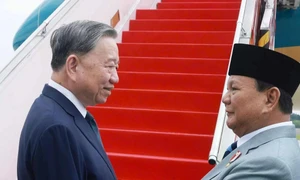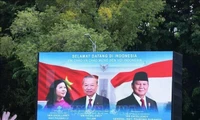
Ninh Binh, home to the UNESCO-recognised Trang An Landscape Complex, would become a heritage urban area, a smart city and a growth pole in the southern part of the Red River Delta, the leader said at a conference announcing the provincial master planning scheme for the 2021-2030 period with a vision until 2050.
He highlighted the important geographical location of Ninh Binh as the intersection between the Red River Delta, and the northwestern mountainous and north-central coastal regions, as well as its unique cultural, historical and ecological values.
Besides, the province is home to one of the country's three largest auto mechanical centres and the leading fruit and vegetable processing centre, he said, stressing its strengths in tourism and handicraft.
Over the past years, it has carried forward such potential and advantages to reap significant socio-economic achievements, with its gross regional domestic product (GRDP) expanding some 7.27% last year, ranking 8th in the Red River Delta and 22nd in the country. The figure stood at 8.02% in the first quarter of this year.
Industry and services have accounted for more than 80% of the province's economic structure, he said, noting that industry has truly become a growth engine and tourism has become a spearhead economic sector.
The achievements have laid a firm foundation for Ninh Binh to further affirm its position on the path of development and integration, the PM said.
Regarding the master planning scheme, the PM said it has opened up new development visions and space, and created new momentum and values for the province, in which the tourism and cultural industry, automobile mechanical industry, innovative startup and ecological, multi-value agriculture serve as the pillars.
PM Chinh suggested the province optimise all legal resources for the realisation of the planning scheme, and implement breakthroughs in strategic infrastructure, the development of services, heritage-based economy, cultural industry and entertainment industry, and in science-technology, innovation, green economy, digital economy, circular economy, sharing economy, knowledge-based economy and climate change response.
At the same time, Ninh Binh needs to ensure compliance, harmony, connectivity, stability, inheritance, development, flexibility and expansion of the master planning scheme during the implementation process, he said.
The leader emphasised the mindset, dynamism, creativity, political determination and responsibility of the provincial Party organisation, authorities, army and people as decisive factors to the work.
To materialise the master planning scheme, the PM urged Ninh Binh to promptly devise and put in place an implementation plan, step up public-private partnership, accelerate administrative reform, pay more heed to education-training and high-quality personnel development, and foster national resources management and environmental protection.
He requested coordination from ministries and centrally-run agencies in the implementation work, and called for support from businesses and investors for Ninh Binh’s development.
Under the master planning scheme, Ninh Binh expects to become a centrally-run city by 2035, and its GRDP growth is set at 9.2% for 2021-2030, and its GRDP per capita, about 200 million VND (7,857 USD). It aims to become one of the 10 localities nationwide with the highest per capita income. /.























